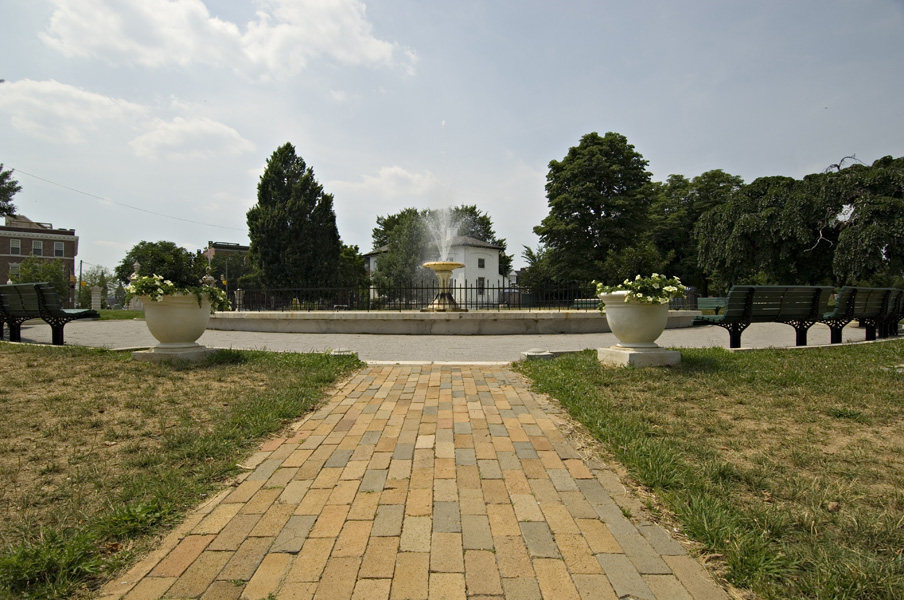A peek behind the scenes: living with a fountain.

What do these unique fountains offer an urban green space? How are they maintained? What could we learn from each other? We needed to know.
The other week, we headed to Baltimore to find out. We pooled together our Firesouls from local Sacred Places that have fountains or other water structures in their green spaces. Firesouls from Johns Hopkins, the Marian House, University of Maryland’s Rehabilitation and Orthopaedic Institute, the Intersection of Change, Baltimore Clayworks,St. Anthony’s, and the Friends of Patterson Park gathered at the League for People with Disabilities (who kindly hosted us all) to break it down.
Moderated by Erin Robertson, our executive director, the conversation was productive and enlightening. We’ve synthesized what we learned below in the name of water-infused idea-sharing from our Nature Sacred Network to you!
Fountains are fantastic, right?
They are. Revitalizing historic fountains can bring tremendous pride and grandeur to neighborhoods—often providing a sense of place, story and history. They can serve as a focal point—a means to come together as a community, hold events and celebrate holidays.
More modern, smaller fountains, or water gardens work very hard to soothe, restore and calm—while offering beauty to its visitors, in parts of cities perhaps not typically nature- or water-accessible.
What happens when they don’t ‘fountain’?
When they’re not working, you know. Right away. Communities become enamored with their fountains and water gardens, and then things get buggy—residents are quick to let you know. And often, for the older fountains, the issues can be larger in scope to fix.
Of course, when they’re on, the impact is tremendous. The fountain at the Intersection of Change in Baltimore’s Sandtown-Winchester is a good example of what a fountain can mean to its community. A glorious fountain, a neighborhood centerpiece, had remained dormant for decades—signaling a social and economic decline in the late 1960s. Over time, a pervasive sense of hopelessness took firm hold—the non-functioning fountain and park became a haven for crime and drugs, earning the moniker “needle park”.
When the Intersection of Change worked to revitalize the area and fountain in the 1990s, it had a profound impact on the community. With a functioning, restored fountain (and a Sacred Place, we’ll note!), the drug culture has dissipated—and in its place a sense of hope is restored. Events are held. Community is rekindled.

OK. The maintenance? What’s that like?
Not easy. Finding reliable fountain maintenance contractors can be challenging—especially with old pumps. Even new pumps—those that reside underwater can too easily be filled with growth (gunk, really) and need to be cleaned. It takes a little digging to find responsive resources who can know how to clean/maintain fountain systems. In Baltimore, David Greenberg recommends Maple Creek Landscapes, and he has had great success with them—Joseph Ridgely is the person get it done.
Perhaps galvanizing a kind of workforce development effort to maintain the spaces—the tasks that don’t require mechanical expertise—could work well to keep the water clean and slow the gunk-building. It could be a great way to encourage youth to get involved and clean the spaces—while helping instill a sense of civic responsibility and pride.
What kinds of programs or events do you hold near your fountain or water garden?
Art classes, yoga, drum circles and music & art therapy sessions are popular programs. Friends of Patterson Park hold their annual wine tasting and fundraiser—a good way to help raise a little capital to keep things, well, flowing (pardon the pun).
We’ll leave you with some inspiration.
Below, scroll to view a quick gallery of some of our Sacred Places’ fountains and water gardens to spark ideation. Feel free to contact us if you have any questions about water elements in urban green spaces—we’d love to hear from you.
[ngg_images source=”galleries” container_ids=”66″ display_type=”photocrati-nextgen_basic_imagebrowser” ajax_pagination=”1″ template=”/nas/content/live/ns2018/wp-content/plugins/nextgen-gallery/products/photocrati_nextgen/modules/ngglegacy/view/imagebrowser-caption.php” order_by=”sortorder” order_direction=”ASC” returns=”included” maximum_entity_count=”500″]

